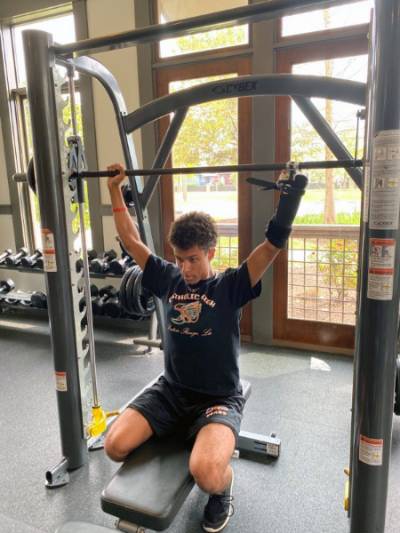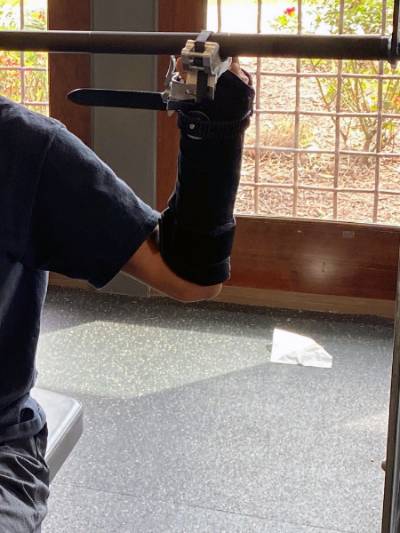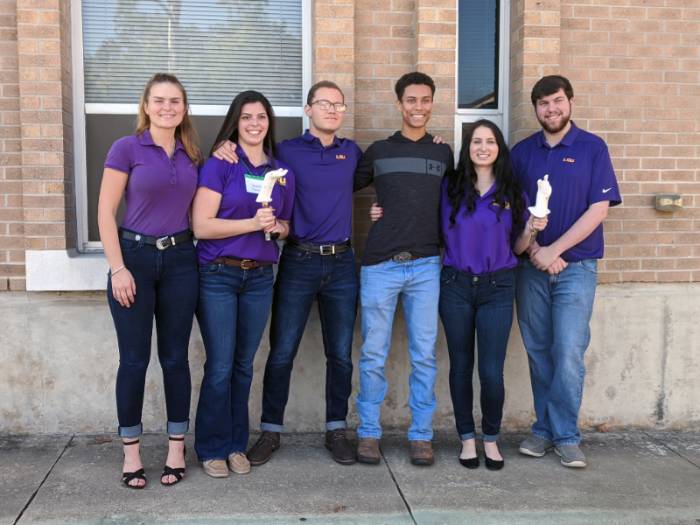LSU Engineering Students Design Prosthetic for Catholic High Student
Device Designed and Constructed in Less Than Nine Months
December 16, 2020
 BATON ROUGE, LA – It’s incredible the chain of events that a chance meeting can set
off.
BATON ROUGE, LA – It’s incredible the chain of events that a chance meeting can set
off.
When LSU Kinesiology Professor of Professional Practice and Athletic Training Program Director Ray Castle stopped by Catholic High School to visit with its head athletic trainer, Eddie Breight, he didn’t know he would meet James Robert III, who was born with half of a palm and no fingers on his left hand.
Robert III, who wanted to weight train for track but couldn’t effectively because of his left arm, didn’t know that Castle would then make a call to Warren Waggenspack, professor of mechanical engineering at LSU, and discuss the possibility of students in LSU’s College of Engineering Capstone Design Program designing a prosthetic to solve the problem.
And none of the five LSU students, now graduates—Gary Couturie, Brette Crocker, Cecilia McAlear, Landon Stein, and Amelie Thomas—knew the impact that working on this one project would have on them. But back to the chain of events.
Robert III, now a senior at CHS, was active in football, basketball, and track upon entering high school. However, he continuously injured his left hand while playing and eventually settled solely on track. Over time, he noticed that his upper body wasn’t developing as fast as his lower body, and while he wanted to work out more, he couldn’t effectively because of his hand.
Robert III and his father were on the verge of creating a homemade prosthetic, with the help of a welder friend, that would help him work out when in walked Castle. Literally.
“I mentioned to Eddie [Breight] that there may be a longshot opportunity to help [Robert III] fulfill his aspirations to play ball with a prosthesis (through) the help of LSU,” Castle said. “I discussed with him how I had worked with Dr. Waggenspack and several groups in [class] ME 2212 previously, and this may be right up their alley as a project. I immediately went outside and called Dr. Waggenspack, and we briefly discussed the project, which he agreed may be a fantastic project.”
The proposal was too late to make the pool from which students are assigned projects in the capstone program during the 2018-2019 academic year but was put forth again in the Fall 2019 semester. This time it was assigned to a team of five students, who all had it as their first choice to work on.
“Upon first hearing about the project, I knew I had to be on the team,” said Couturie, who graduated in May 2020 with bachelor’s in mechanical engineering and now works as a data analyst with Project Consulting Services. “At the time, I was pursuing powerlifting as a hobby. Lifting weights had changed my life in some not-so-insignificant ways, and being able to help someone change their life through this hobby as well was a tremendous opportunity to me.”
 The students worked under the guidance of Mechanical Engineering Professor Hunter
Gilber, spending the fall semester developing the conceptual design and getting input
from Robert III. They did interviews with him and observed his workouts. They researched
existing products and solutions, and they spoke to kinesiology and mechanical engineering
faculty, as well as a prosthetist.
The students worked under the guidance of Mechanical Engineering Professor Hunter
Gilber, spending the fall semester developing the conceptual design and getting input
from Robert III. They did interviews with him and observed his workouts. They researched
existing products and solutions, and they spoke to kinesiology and mechanical engineering
faculty, as well as a prosthetist.
“At the beginning of the fall semester, we sat down with [Robert III] to establish his weightlifting goals,” said McAlear, who graduated in May 2020 with a bachelor’s in biological engineering and is currently working towards her PhD in biomedical engineering at Tulane University. “He was aiming for a maximum deadlift of 450 lbs. and a maximum barbell curl of 100 lbs. [Robert III] has a partial thumb and a middle digit on his left hand, so our prosthesis would need to stabilize and secure the weights for him. For safety reasons, we decided to implement a thumb-activated, quick-releasing mechanism into the prosthesis so the loads lifted could be released as close to instantaneously as possible.
“After several iterations, our brilliant teammate [Coutourie] came up with a design that used capstan mechanical advantage. [Robert III] would thread a strap over the barbell and through three angled capstans, securing the strap (and effectively the load) in place using an optimally positioned spring-loaded toggle clamp. A flick of [Robert III’s] left thumb would release the load from the clamp. Both analysis and testing supported the design.”
The second challenge, McAlear added, was ensuring the prosthesis wouldn’t involuntarily slip from Robert III’s arm when a large load was applied. The team ultimately included a chest strap harness into the design for lifting large weights.
As the team worked on the device during the spring 2020 semester, the COVID-19 pandemic caused LSU to close its campus in mid-March, cutting the fabrication stage of the project short. Luckily, much of the manufacturing was completed fairly quickly in the days leading up to the shutdown. While Couturie said the extra time would have allowed the team to deliver a more aesthetically pleasing and polished prosthetic, the students were happy with the finished product.
In fact, the only person more pleased with the final product when it was delivered in May was Robert III himself.
“When I was first able to use the prosthetic in a full team workout, I honestly cried,” he said. The feeling was almost that of invincibility. Imagine never being able to pick up a spoon to feed yourself, then all of a sudden being able to lift 200 pounds over your head. That day is burned in my memory and will absolutely remain with me for the rest of my days.”
 “For his dad and I, it was a proud moment to see him and his team accomplish what
he set out to do,” said Deidre Robert, James’ mother. “We had two previous teams that
brought forth design, concept and wonderful thoughts but no product. It was a moment
of joy to see him fully workout and to see him so happy and fulfilled at that moment.
“For his dad and I, it was a proud moment to see him and his team accomplish what
he set out to do,” said Deidre Robert, James’ mother. “We had two previous teams that
brought forth design, concept and wonderful thoughts but no product. It was a moment
of joy to see him fully workout and to see him so happy and fulfilled at that moment.
“We couldn’t ask for a better village of folks at Catholic and LSU to assist James on the journey. From the coaches to the students who touched this project along the way, to the administrators at both schools, we say thank you. Thank you for helping a young man with a desire and a dream to do more and be more.”
In the end, the project changed the students’ lives as much as it did Robert III’s.
“I helped a gracious and talented human being fulfill a dream,” McAlear said. “There is no greater feeling than that. This project also helped me feel validated as an engineer.”
“I cannot stress enough how lucky, or special, or whatever you want to call it this team means to me,” said Amelie Thomas, who graduated with a bachelor’s in mechanical engineering in May 2020 and is pursuing an online MBA through Texas A&M International University. “We are close friends, and I hope that we stay that way. I’m very proud of the relationships I have built with this team.”
Learn more about the Capstone Design Program, or submit a proposal for a project.
Like us on Facebook (@lsuengineering) or follow us on Twitter and Instagram (@lsuengineering).
###
Contact: Joshua Duplechain
Director of Communications